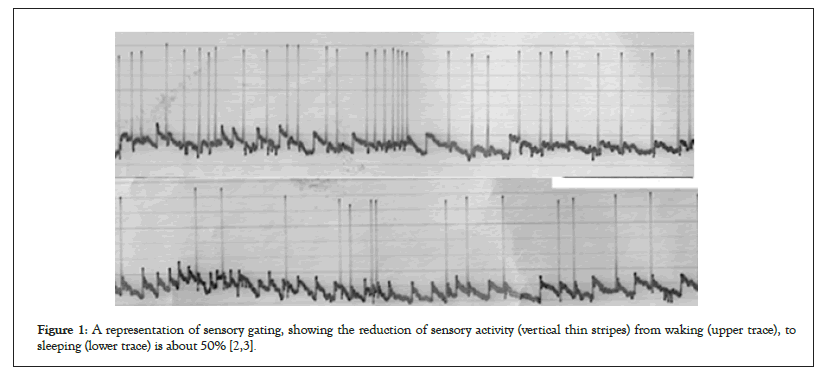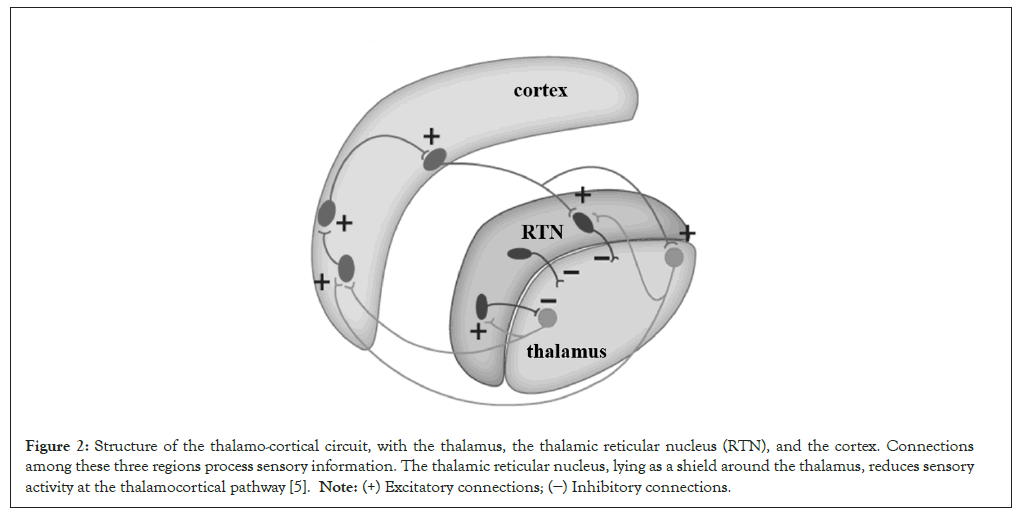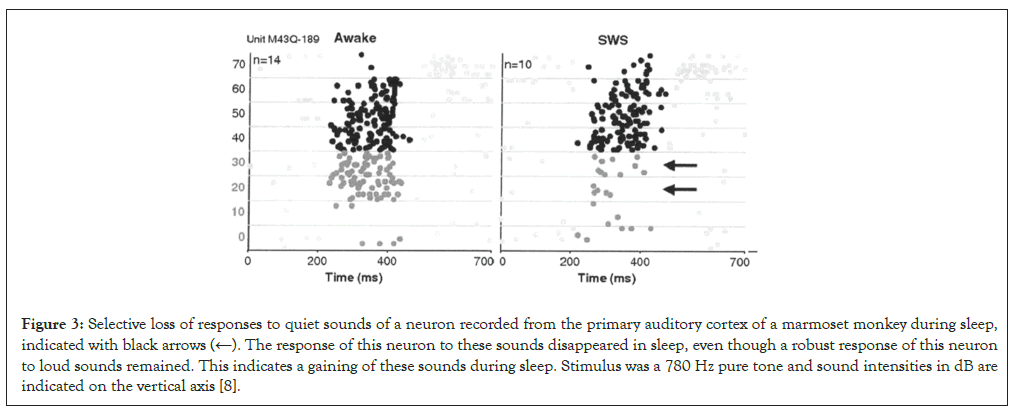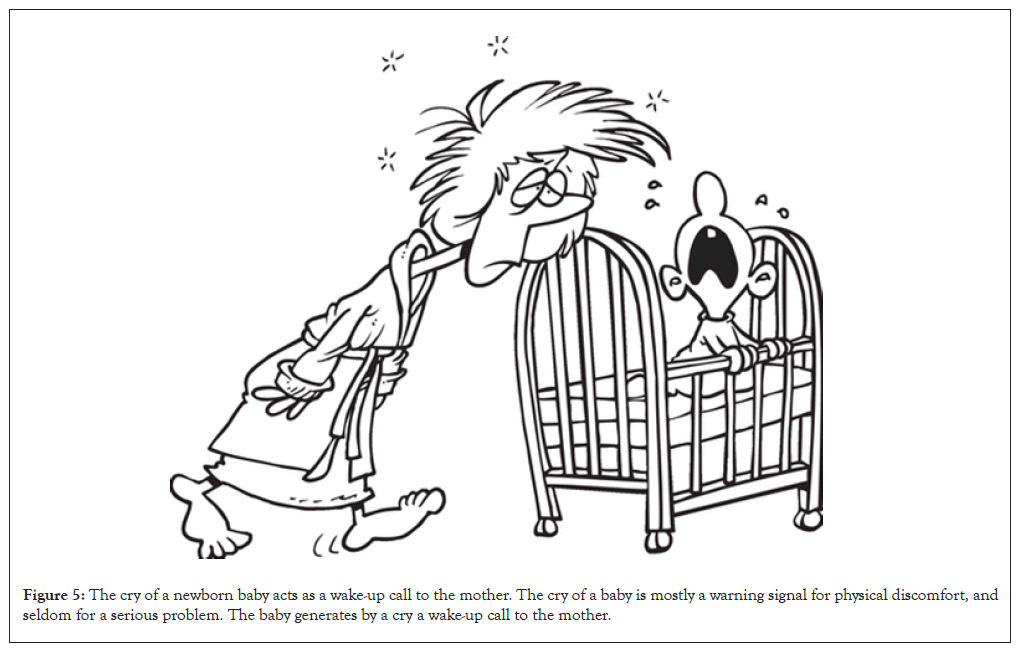Journal of Sleep Disorders & Therapy
Open Access
ISSN: 2167-0277
ISSN: 2167-0277
Review Article - (2024)
Sleep is a vulnerable process for two reasons. Firstly, the comfort to sleep onset and maintenance is strenuous for many people, and secondly the diminished ability in sleep to monitor the environment reduces the action to risky and relevant events. The ease to sleep is regulated by a mechanism called ‘sensory gating’, controlling the amount of stimulus input to the brain. The monitoring of the sleep environment for external threats and situations, is done by ‘sensory gaining’, a complex brain mechanism leading to a subconscious representation of the sleep environment, which makes reactions possible. In short, sensory gating protects the sleep, while sensory gaining protects the sleeper. Both the sensory gating and gaining systems are in detail described in this paper.
Sleep; Brain; Sensory gaining; Subconscious; Relaxation
Sleep is a vulnerable brain state, characterized by a low vigilance level and a diminished consciousness. Two important mechanisms are relevant in sleep. The first mechanism is ‘sensory gating’, the reduction of the incoming flow of sensory information during sleep [1]. The brain contains a mechanism that reduces the flow of incoming sensory input during sleep compared to waking. Sometimes this reduction mechanism is not strong enough. It is well-known that sleep is impaired by a too high cerebral activation, either produced by strong environmental stimuli or by obsessive and repetitive negative thinking in sleep (‘rumination’). When the high brain activation is decreased by relaxation techniques, sleep is generally improved. Also sleeping medication enhancing the inhibition of the afferent sensory stimuli, improves sleep. The second mechanism is ‘sensory gaining’, a complex brain mechanism that the sleeper protects for incidents and risks during sleeping time. A low degree of consciousness may decrease the ability to react, but the sensory gaining mechanism safeguards the sleeper for abnormal and dangerous situations. It does this by constantly analyzing the sleep environment. A sleeping individual becomes subconsciously aware of what is happening in the environment and can make decisions to perform a subconscious reaction or diminishes the risk chances with a wake-up call.
Sensory gating to protect sleep
During sleep a considerable reduction compared to waking exists of the afferent flow of sensory activity to the cerebral cortex of all sensory systems (Figure 1 ) [2,3]. The relay cells in the thalamus are firstly inhibited by the interneurons during sleep, but the real reduction is provided by the reticular thalamic nucleus. The brainstem reticular formation plays a main role in sleep by activating the neurons in the reticular thalamic nucleus. When the neurons in this nucleus are activated, it results in a reduction of the external sensory stimuli travelling over the thalamocortical pathway to the cerebral cortex. This reduction is estimated to about half of the original generated activity. It is already long known that a reduction of the external sensory activity facilitates sleep onset and sleep maintenance, but recently, Lewis et al., noted that indeed a specific activation of the reticular thalamic nucleus rapidly induces a state of sleepiness (Figure 2) [4]. The induced sleep was observed both at the electrophysiological and the behavioral level. The overall conclusion is inevitable that a reduction of the flow of sensory inputs to the cortex by inhibition at the thalamocortical level promotes sleep onset and sleep maintenance, and the reticular thalamic nucleus is mainly responsible for sensory gating, which protects sleep.

Figure 1: A representation of sensory gating, showing the reduction of sensory activity (vertical thin stripes) from waking (upper trace), to sleeping (lower trace) is about 50% [2,3].

Figure 2: Structure of the thalamo-cortical circuit, with the thalamus, the thalamic reticular nucleus (RTN), and the cortex. Connections among these three regions process sensory information. The thalamic reticular nucleus, lying as a shield around the thalamus, reduces sensory activity at the thalamocortical pathway [5]. Note: (+) Excitatory connections; (−) Inhibitory connections.
The overall conclusion is inevitable that a reduction of the flow of sensory inputs by thalamocortical inhibition promotes sleep. The reticular thalamic nucleus seems to play a pivotal role in this sleep protection. It is now understandable that a cerebral activation or an active rumination during sleep leads to sleep impairments, but also that adequate sleep medicines and relaxation techniques might improve sleep.
Sensory gaining to protect the sleeper
Sleep is indispensable for both mind and body but can take place in a rather vulnerable environment for the sleeper. Humans and animals sleep often sleep in an immobile and unprotected position, while events surrounding them might require a fast arousal from the sleeping state. Especially, the auditory system is a pivotal and fundamental system for the brain to reflect properties of distant and proximal signals. This system carries valuable information for the sleeper, such as risk and danger or the cry for help of a person. The auditory pathway brings the sensory information to cortical areas while asleep, to indicate relevant signals. Dangerous signals in the environment, for instance a weak rustle for sleeping hare in the open field or a noise of a newborn baby for the young mother, are examples of stimuli easily arousing people even when such stimuli are rather gentle. It is indeed well known that a sleeping person can be awakened not only by intense stimuli, but also by soft stimuli which have a meaning for the sleeper. Dangerous and relevant signals even gentle in the environment, are examples of stimuli which easily arouse and awake people. This implies that the meaning of these stimuli have to be recognized by the sleeping brain [6,7].
Gaining is an important aspect of making relevant stimuli more obvious. Issa et al., showed the loudness increase of sound stimuli in marmoset monkeys [8]. At first they confirmed the general finding that the response of cortical neurons is considerable weaker during sleep compared to waking. This implies that quiet sounds elicit weaker responses in sleep. However, in the primary auditory cortex loud sounds, always associated with a sense of emotions or danger, evoke similar responses in sleep compared to waking. This implies the existence of a gain mechanism for certain sounds during sleep at the level of the cerebral cortex (Figure 3).

Figure 3: Selective loss of responses to quiet sounds of a neuron recorded from the primary auditory cortex of a marmoset monkey during sleep, indicated with black arrows (←). The response of this neuron to these sounds disappeared in sleep, even though a robust response of this neuron to loud sounds remained. This indicates a gaining of these sounds during sleep. Stimulus was a 780 Hz pure tone and sound intensities in dB are indicated on the vertical axis [8].
The auditory system is strongly involved in the recognition of relevant stimuli, but is not the only one. Why falls a sleeping person never out of the bed? People often believe that we lie unconsciously in bed and that we have no idea what is happening around us. But that is not entirely true. When asleep, the brain is still working and we have some knowledge of the position in bed and we are even prevented for falling out of the bed. The somatosensory system, with mechanoreceptors in the skin, is an important system and ensures that the sleeper ‘subconsciously’ knows what his position in bed is. When the body comes too close to the bedside, the sleeper gets a warning signal so that he ‘subconsciously’ moves to a safer place in the bed. The somatosensory system has a function to determine the position in bed but also in the situation when the sleeper is required to move or to turn one’s body to prevent insufficient blood circulation to overcome a numbed arm or stiff muscles. Moreover, it awakens a person when the urge to urinate is rather strong. The auditory system and the somatosensory system are mainly involved in the gaining system, but gaining examples from the visual system are hard to find.
Now it is understandable that sensory gating results in maximal 50% reduction of the sensory input and this percentage cannot be much lower, because the preserved activity of the sensory information to the cerebral cortex is necessary to inspect the sleep environment for the protection of a sleeper. Several studies are undertaken what a sleeping brain can do with the preserved information the brain receives while asleep. Studies show that the sleeping brain is limited compared to the waking brain [9]. Higher forms of processing have not been proven, and learning a foreign language seems illusory, but the shallow analysis of external information during sleep is possible and highly relevant.
Mechanism of sensory gaining
The sleep-reduced sensory information of external stimuli ascends from thalamus to layer 4 of the primary cortex, where the information is integrated through interaction with neurons with personal knowledge of layers 5 and 6 [10]. From this cortical processing emerges a sharper perception of the external stimuli by ‘egocentric selection’ which also implies extra gaining of relevant stimuli for the person and extra suppression of distractive stimuli [11,12]. Moreover, egocentric selection modulates the information according to the current brain state, with respect to vigilance, attention, emotions and memory representations [13]. Axons of cortical layers 5 and 6 neurons make up the corticofugal pathway, which projects the adjusted and modulated stream of information back to several subdivisions of the thalamus [10]. The complexity of this corticofugal circuit of sensory processing is apparent in the overwhelming number of non-sensory modulatory inputs received by thalamic cells, whereas sensory inputs which are the main driving inputs, are estimated to account for no more than one tenth of all inputs [14]. Corticofugal projections targeting to thalamocortical relay cells of the thalamic subdivisions are generally excitatory. The information flow from this thalamic subdivision is directed to the prefrontal cortex, where it can bind with all other modalities. The prefrontal cortex is a higher association part of the sensory cortices, where the information of all sensory systems after binding forms a representation of the sleep environment, which becomes subconscious to the sleeper.
This complex double thalamocortical circuit connects the environment via the thalamus with the cerebral cortex. The primary cortex forms the heart of sensory processing, receiving and adjusting the reduced external information and, together with the corticofugal system, provides the higher cortical areas with information from all sensory modalities. In the prefrontal area the binding takes place of all sensory modalities. The bounded information is integrated in an imagination map representing the subconscious awareness of the environment. The sleeper is subconsciously aware of what is going on in the environment and can make decisions, perform a (sub)conscious motor reaction or might indicate the relevance with a wake-up call [15]. This complex sensory brain system of sensory gating and gaining is scheduled in Figure 4. External sensory input reduced by the reticular thalamic nucleus (rTN) (1), targets via the thalamocortical pathway to layer 4 at the primary cortex. In interaction with layers 5 and 6, the input is modulated by egocentric selection (2) and amplified (2). It is send by the corticofugal pathway back to a thalamic subdivision (3) and then send to the prefrontal cortex (4,5). At this area the input binds to all other sensory modulations (6), and a subconscious awareness of the environment becomes present (7). This is eventually followed by a subconscious reaction or by a wake-up call in conscious awareness (8). The drawing is based on data from Sherman et al., Briggs et al., and Coenen et al., [16-18].

Figure 4: The brain mechanisms of sensory gating and gaining are schematized in this diagram.
An essential function of the thalamus is to control the flow of sensory information to the cerebral cortex during sleep. The reduction of the input by the reticular thalamic nucleus by half the flow of the incoming sensory activity to the cerebral cortex. facilitates sleep onset and maintenance. The brains of people having difficulties with sleep onset or sleep maintaining are mostly too excited. Before going to sleep these people are worrying about problems and concerns and the elevated activity prevents an acceptable sleep onset. Moreover, during sleep they often have repetitive negative thoughts (‘rumination’) with a deficient sleep. A vicious circle might even result in psychophysiological insomnia, which is the reason for most of the sleep problems. Relaxation techniques, and adequate sleep medication can help to decrease the brain activity, but the development of adequate sleep therapies is not yet fully developed. Reduction of the brain input by strong sedative drugs is not recommended and even dangerous, because the preserved information is necessary for the analysis of the sleep environment. Sleep benefits from the right input, it should not be too high, because this disturbs sleep, and not too low, because a certain input is necessary for the sleeper to monitor the sleep environment for safety and well-being.
The sleep-reduced information of the sensory stimuli ascends from the thalamus to the primary cortex, in particular to layer 4. There takes an integration place with cortical neurons of layers 5 and 6. They sharpen up the input by selective selection, a puzzling process in which relevant personal characteristics together with features of the current brain state with respect to attention, emotions and memory, are sharply gained into the flow of stimuli. Moreover, neuronal responses for most relevant stimuli and impulses are enhanced and distractive stimulations and activities are suppressed.
The corticofugal pathway brings the modulated and gained sensory information finally to the prefrontal cortex. The sensory gained and adapted input from one modality binds in the prefrontal area to all other sensory modalities. After binding a sensory imagery map is present, representing the sleep environment. This results in a subconscious imagination and encoding of the sleeping environment with relevant features. A subconscious motor reaction can follow or eventually, when the danger is actual a conscious wake-up call can be produced preparing the awake sleeper for an adequate reaction (Figure 5) [18,19]. In this way the sleeper is assured from safety and well-being.

Figure 5: The cry of a newborn baby acts as a wake-up call to the mother. The cry of a baby is mostly a warning signal for physical discomfort, and seldom for a serious problem. The baby generates by a cry a wake-up call to the mother.
Sleep of an individual is protected by an adequate level of sensory input due to sensory gating. This is mainly performed by the reticular thalamic nucleus, which takes care for a reduction of the sensory input. Nevertheless, sufficient preserved sensory input is necessary for sensory gaining, which ensures that by the complex corticofugal system a map of the sleep environment is achieved in the cognitive cortical area. Subconsciously the sleeper is aware of this map. This save guards the sleeper for deviant and risk factors and might arouse him for relevant actions. In this way gating and gaining assures the sleeper that he gets through the entire sleep night in a proper, healthy and safe way. By these features of sensory gating, with adequate relaxation of the brain, and by sensory gaining, with awareness of the sleep environment, the ‘vigilant sleeper’ is born.
[Crossref] [Google Scholar] [PubMed]
[Crossref] [Google Scholar] [PubMed]
[Crossref] [Google Scholar] [PubMed]
[Crossref] [Google Scholar] [PubMed]
[Crossref] [Google Scholar] [PubMed]
[Crossref] [Google Scholar] [PubMed]
[Crossref] [Google Scholar] [PubMed]
[Crossref] [Google Scholar] [PubMed]
[Crossref] [Google Scholar] [PubMed]
[Crossref] [Google Scholar] [PubMed]
[Crossref] [Google Scholar] [PubMed]
[Crossref] [Google Scholar] [PubMed]
[Crossref] [Google Scholar] [PubMed]
[Crossref] [Google Scholar] [PubMed]
Citation: Coenen A (2024). Sensory Gating Protects Sleep, Sensory Gaining Protects the Sleeper. J Sleep Disord Ther. 13:001.
Received: 12-Sep-2024, Manuscript No. JSDT-24-34021; Editor assigned: 16-Sep-2024, Pre QC No. JSDT-24-34021 (PQ); Reviewed: 30-Sep-2024, QC No. JSDT-24-34021; Revised: 07-Oct-2024, Manuscript No. JSDT-24-34021 (R); Published: 14-Oct-2024 , DOI: 10.35248/2167-0277.24. S1.001
Copyright: © 2024 Coenen A, et al. This is an open-access article distributed under the terms of the Creative Commons Attribution License, which permits unrestricted use, distribution, and reproduction in any medium, provided the original author and source are credited.